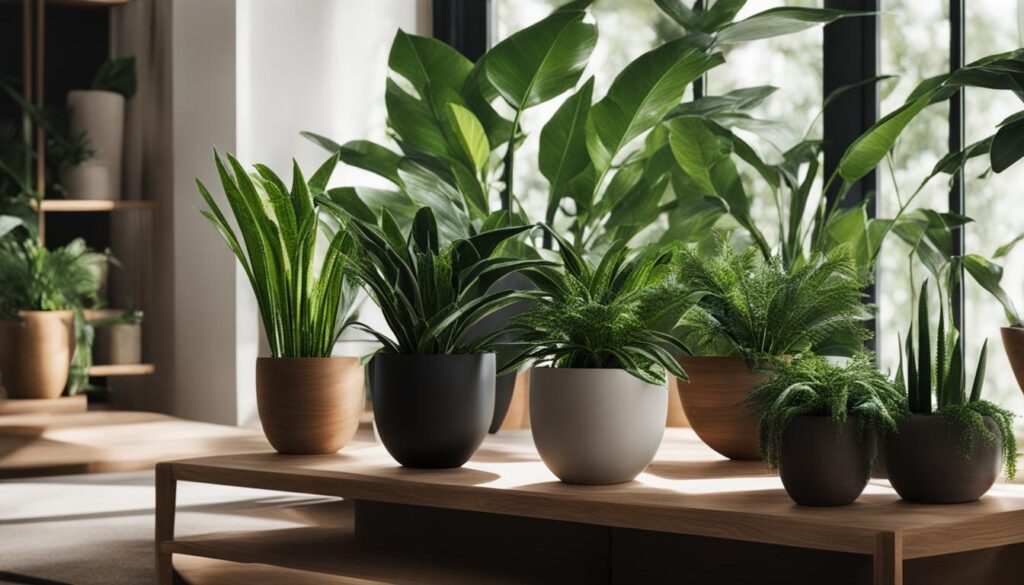Welcome to my blog post on air quality in your home! In today’s fast-paced world, it’s essential to prioritize our health and well-being, especially when it comes to the air we breathe indoors. Did you know that indoor air pollution can be two to five times worse than outdoor air pollution? Poor indoor air quality can lead to a range of health issues, from allergies and respiratory problems to more severe conditions. But don’t worry, there are plenty of natural and effective ways to improve the air quality in your home.
Throughout this article, I will explore various techniques and solutions to enhance indoor air quality, ranging from reducing volatile organic compounds (VOCs) to utilizing air purifiers. I will also delve into the importance of maintaining a clean and healthy indoor environment and provide you with DIY approaches to achieve cleaner air without breaking the bank.
Whether you are a health-conscious individual or simply want to create a safe space for yourself and your loved ones, this article will equip you with the knowledge and tools to breathe easy in your home.
Key Takeaways:
- Indoor air pollution can have detrimental effects on our health.
- Poor indoor air quality can worsen respiratory conditions and allergies.
- Reducing VOCs and utilizing air purifiers are effective ways to improve indoor air quality.
- Maintaining a clean and healthy indoor environment is crucial for overall well-being.
- Implementing DIY approaches can be cost-effective and beneficial for cleaner indoor air.
Understanding Indoor Environmental Quality
Indoor environmental quality refers to the overall condition of the indoor environment in terms of air quality, temperature, humidity, lighting, and noise levels. Understanding and maintaining a high level of indoor environmental quality is essential for creating a healthy and comfortable living space. In this section, we will explore the factors that can affect indoor air quality, which is a significant component of indoor environmental quality.
Factors Affecting Indoor Air Quality
Indoor air quality can be influenced by various factors. These factors include:
- Human Activities: Activities such as cooking, cleaning, and smoking can release pollutants into the air, leading to decreased air quality.
- Building Materials: Construction materials, furniture, carpets, and paint can emit volatile organic compounds (VOCs) and other harmful substances, negatively impacting indoor air quality.
- Biological Contaminants: Mold, pollen, pet dander, and dust mites can contribute to poor indoor air quality and allergies.
By understanding these factors, we can take proactive steps to improve and maintain optimal indoor air quality in our homes.
To visualize the factors affecting indoor air quality, refer to the table below:
| Factors Affecting Indoor Air Quality |
|---|
| Human Activities |
| Building Materials |
| Biological Contaminants |
Understanding these factors is vital for implementing effective strategies to improve indoor air quality and create a healthier living environment for ourselves and our loved ones.
The Hidden Dangers of Indoor Air Pollution
Indoor air pollution poses a significant threat to our health and well-being. Many common airborne contaminants can lurk in our homes, silently affecting the air we breathe. Understanding these hidden dangers is crucial in creating a safe and healthy indoor environment.
Identifying Common Airborne Contaminants
When it comes to indoor air pollution, knowledge is power. Being aware of the common airborne contaminants that can be present in our homes allows us to take the necessary steps to mitigate their impact. Some of these contaminants include:
- Allergens: Substances such as pollen, dust mites, pet dander, and mold spores can trigger allergies and respiratory issues.
- Asbestos: Found in older homes, asbestos fibers can be released into the air when disturbed, posing a serious health risk.
- Carbon monoxide: This colorless and odorless gas is produced by appliances and can lead to poisoning if not properly ventilated.
- Formaldehyde: Commonly found in building materials, furniture, and household products, formaldehyde can cause respiratory irritation and other health problems.
- Mold: Excessive moisture and poor ventilation can lead to mold growth, which can trigger allergies and respiratory issues.
- Pesticides: The use of pesticides indoors can lead to the release of harmful chemicals that can be detrimental to our health.
- Radon: A naturally occurring radioactive gas, radon can penetrate buildings and increase the risk of lung cancer.
- Smoke: Tobacco smoke and other types of smoke, such as from cooking or wood-burning appliances, can release harmful particles and chemicals into the air.
Identifying these common airborne contaminants is the first step in addressing indoor air pollution and taking appropriate measures to improve air quality.
Health Impacts of Poor Indoor Air Quality
Poor indoor air quality can have profound effects on our health. Exposure to indoor air pollutants can lead to various health issues, including:
- Respiratory diseases: The inhalation of pollutants can worsen asthma symptoms and contribute to the development of respiratory conditions.
- Cardiovascular issues: Certain pollutants, such as fine particles and carbon monoxide, can increase the risk of heart attacks, strokes, and other cardiovascular problems.
- Cognitive effects: Studies have shown that exposure to indoor pollutants can impair cognitive function, affecting memory, attention, and decision-making abilities.
- Cancer: Prolonged exposure to certain airborne contaminants, such as radon and asbestos, can increase the risk of developing lung cancer and other types of cancer.
It is important to recognize the potential health impacts of poor indoor air quality and take proactive steps to minimize exposure for a healthier living environment.
At-risk Populations
While poor indoor air quality can impact anyone, certain populations are more susceptible to the adverse effects. At-risk populations include:
- Children: Developing respiratory systems and immune systems make children more vulnerable to the effects of indoor air pollution.
- Older adults: Age-related changes in the respiratory and cardiovascular systems can increase the risk of complications from indoor air pollutants.
- Individuals with preexisting conditions: Those with allergies, asthma, heart disease, or other chronic respiratory or cardiovascular conditions may be more sensitive to indoor air pollution.
- Native Americans: Some Native American communities may face increased exposure to indoor air pollutants due to factors such as housing conditions, traditional practices, and geographic location.
- Individuals with low socioeconomic status: Limited access to clean and healthy housing can exacerbate the impact of indoor air pollution on individuals with low socioeconomic status.
Recognizing these at-risk populations is crucial in implementing targeted strategies to protect their health and well-being.
| Airborne Contaminant | Health Impacts |
|---|---|
| Allergens | Respiratory issues, allergies |
| Asbestos | Lung cancer, mesothelioma |
| Carbon monoxide | Poisoning, cardiovascular effects |
| Formaldehyde | Respiratory irritation, cancer risk |
| Mold | Allergies, respiratory issues |
| Pesticides | Neurological effects, respiratory issues |
| Radon | Lung cancer |
| Smoke | Respiratory issues, cardiovascular effects |
Indoor Air Quality Solutions
How to Improve Indoor Air Quality in Your Home
To create a clean and healthy indoor environment, it is essential to take proactive steps to improve indoor air quality. By reducing indoor air pollution, you can enhance the overall health and well-being of yourself and your loved ones. Here are some practical tips and strategies to help you achieve cleaner indoor air:
- Proper ventilation: Ensure adequate airflow in your home by opening windows and using exhaust fans. This helps to remove stale air and pollutants and brings in fresh outdoor air.
- Regular cleaning: Dust, vacuum, and mop your home regularly to minimize the accumulation of allergens, dust mites, and other pollutants. Pay special attention to carpets, upholstery, and pet areas.
- Reducing sources of pollutants: Be mindful of potential sources of indoor air pollution, such as smoking, chemical cleaners, and certain building materials. Limit their use or opt for healthier alternatives.
- Using air purifiers: Consider investing in an air purifier with a HEPA (High-Efficiency Particulate Air) filter to effectively remove airborne contaminants, including dust, pollen, pet dander, and mold spores.
By implementing these tips, you can significantly improve the indoor air quality of your home. Remember, maintaining clean and fresh indoor air is crucial for your health and the well-being of everyone in your household.
| Tips for Clean Indoor Air: | Benefits |
|---|---|
| Proper ventilation | Removes stagnant air and brings in fresh outdoor air. |
| Regular cleaning | Reduces allergens, dust mites, and other pollutants. |
| Reducing sources of pollutants | Minimizes the presence of harmful chemicals and materials. |
| Using air purifiers | Effectively filters out airborne contaminants. |
Natural Ways to Enhance Indoor Air Quality
Some great indoor air quality tips for improving indoor air quality do not always require expensive air purifiers or complex systems. There are simple and natural methods that can effectively enhance the air we breathe in our homes. This section will explore two key approaches to naturally enhance indoor air quality: using plants for air purification and maximizing air circulation through open windows.
Best Plants for Indoor Air Purification
Plants not only add beauty to our indoor spaces but also have the remarkable ability to naturally remove pollutants from the air through a process called phytoremediation. Some plant species are particularly effective at filtering out common airborne contaminants and can greatly improve indoor air quality.
A study conducted by NASA highlighted several plants that excel at air purification, including:
- Areca Palm
- Peace Lily
- Spider Plant
- Snake Plant
- English Ivy
- Boston Fern
These plants have been shown to have the ability to remove harmful volatile organic compounds (VOCs) such as formaldehyde, benzene, and ammonia from the air.

Maximizing Air Circulation with Open Windows
Opening windows is a simple yet effective way to promote air circulation and improve the quality of the indoor air. Fresh airflow from the outdoors helps to dilute indoor pollutants and expel them from the space.
Maximizing air circulation is particularly beneficial in areas where outdoor air quality is good. Opening windows on opposite sides of the room creates a cross-ventilation effect that helps in removing stagnant air and replacing it with fresh, clean air.
Additionally, opening windows regularly allows for the release of built-up humidity and moisture, reducing the risk of mold growth, and helping to maintain a healthy indoor environment.
By incorporating these natural methods of enhancing indoor air quality, we can create cleaner and healthier living spaces without relying solely on artificial air purification systems.
Reducing VOCs in Indoor Spaces
Volatile organic compounds (VOCs) are chemicals that can be emitted as gases from certain products and materials. These compounds can contribute to poor indoor air quality and have negative health effects. To create a safer and healthier indoor environment, it is important to reduce VOCs in our living spaces.
Materials and Products to Avoid
When selecting materials and products for our homes, it is crucial to choose those with low VOC content. Here are some common items that may emit VOCs and should be avoided:
- Paints: Traditional paints often contain high levels of VOCs. Opt for low- or zero-VOC paints that are labeled as environmentally friendly.
- Cleaning Products: Many conventional cleaning products release VOCs into the air. Look for natural and organic alternatives that are free of harsh chemicals.
- Furniture and Flooring: Certain furniture and flooring materials, such as particleboard, carpets, and laminate flooring, can release VOCs. Consider choosing sustainable options made from natural materials or those labeled as low-VOC.
- Adhesives and Sealants: Glues, caulks, and sealants can contain high levels of VOCs. Look for products labeled as low- or no-VOC, especially when working on renovation or construction projects.
Safe Alternatives to Conventional Products
Fortunately, there are safe alternatives available to replace conventional products that emit VOCs. Consider the following options:
- Low- or Zero-VOC Paints: These paints are formulated to emit fewer harmful chemicals and odors. They are available in a variety of colors and finishes.
- Natural Cleaning Solutions: Create your own cleaning solutions using natural ingredients like vinegar, baking soda, and essential oils. These alternatives are effective and safe for both your health and the environment.
- Wood and Bamboo Furniture: Choose furniture made from sustainably sourced wood or bamboo. These materials emit fewer VOCs compared to synthetic options and are also more environmentally friendly.
- Hardwood and Cork Flooring: Consider installing hardwood or cork flooring, both of which have lower VOC emissions compared to carpets or vinyl flooring. These natural materials are more durable and can enhance the overall aesthetics of your space.
- Eco-Friendly Adhesives: Use adhesives and sealants labeled as low- or no-VOC when necessary. These safer alternatives will help minimize VOC exposure during installation or repair projects.
By being conscious of the materials and products we choose, we can significantly reduce VOCs in our indoor spaces, creating a healthier and more sustainable environment for ourselves and our loved ones.
Effective Solutions for Removing Indoor Air Pollutants
Indoor Air Quality Solutions
To improve indoor air quality and create a healthier living environment, it is essential to implement effective solutions that can remove indoor air pollutants. In this section, we will explore some of the most reliable methods for purifying the air in your home and ensuring clean and fresh indoor air.
How to purify indoor air?
One of the most effective solutions for removing indoor air pollution is the use of air purification systems. These systems are designed to capture and eliminate a wide range of contaminants, including dust, pollen, pet dander, mold spores, and harmful chemicals. Two popular types of air purifiers are HEPA filters and activated carbon filters.

HEPA (High-Efficiency Particulate Air) filters are highly efficient at trapping tiny particles as small as 0.3 microns. They can remove up to 99.97% of airborne pollutants, making them ideal for individuals with allergies or asthma. These filters work by forcing air through a fine mesh that captures contaminants, preventing them from circulating in the indoor environment.
Activated carbon filters, on the other hand, are excellent at removing odors, gases, and volatile organic compounds (VOCs) from the air. The activated carbon material has a porous structure that attracts and absorbs these pollutants, resulting in cleaner and fresher indoor air.
In addition to using air purification systems, it is crucial to regularly maintain and replace HVAC filters in your home. HVAC (Heating, Ventilation, and Air Conditioning) filters are responsible for trapping airborne particles and preventing them from entering your living spaces. Over time, these filters can become clogged and less effective, allowing pollutants to recirculate. Regularly cleaning or replacing HVAC filters is essential for maintaining clean indoor air and ensuring the optimal performance of your heating and cooling system.
By implementing these effective solutions for removing indoor air pollutants, you can significantly improve the quality of the air you breathe in your home. Clean and fresh indoor air contributes to a healthier living environment, reducing the risk of respiratory issues, allergies, and other potential health problems associated with poor indoor air quality.
The Role of Air Purifiers in Your Home
Air purifiers play a crucial role in improving the air quality in your home. By removing airborne contaminants, they can help create a clean and healthy environment for you and your family.
Understand the Types of Air Purifiers
There are several types of air purifiers available, each with its own filtration method and benefits:
- HEPA filters: These purifiers use High-Efficiency Particulate Air (HEPA) filters to capture 99.97% of airborne particles as small as 0.3 microns, including dust, pollen, pet dander, and mold spores.
- Activated carbon filters: These purifiers use activated carbon to adsorb odors, chemicals, and volatile organic compounds (VOCs) from the air, making them an excellent choice for eliminating unwanted smells.
- Ozone generators: These purifiers produce ozone, which is intended to neutralize odors and kill bacteria and viruses. However, ozone generators should be used with caution and in well-ventilated areas, as high levels of ozone can be harmful to human health.
Choosing the Right Air Purifier for Your Space
When selecting an air purifier for your home, consider the following factors:
- Room size: Choose a purifier that is suitable for the size of the room you want to purify. Check the manufacturer’s specifications to ensure the purifier is capable of effectively filtering the air in your space.
- Filtration needs: Identify the specific pollutants you want to target, such as allergens, odors, or chemicals. Select an air purifier with the appropriate filtration technology to address your specific needs.
- Budget: Set a budget that works for you and compare the features and performance of different air purifiers within that range. Remember to consider not only the initial cost but also the long-term expenses, such as filter replacements.
Indoor Air Quality Solutions for Pet Owners
Pet owners understand the joy and companionship that our furry friends bring into our lives. However, owning pets also comes with the responsibility of ensuring good indoor air quality for both our loved ones and ourselves. In this section, I will provide you with practical solutions to reduce pet allergens in your home.
1. Regular Grooming: Make sure to groom your pets frequently to minimize shedding and dander in your home. Brushing their fur and giving them regular baths can significantly reduce allergens in the air.
2. Clean and Vacuum: Regularly clean and vacuum your home, paying special attention to areas where your pets spend the most time. Use a vacuum cleaner with a high-efficiency particulate air (HEPA) filter to effectively trap pet dander and allergens.
3. Create Pet-Free Zones: Designate specific areas in your home as pet-free zones, such as bedrooms or certain rooms. This will help minimize allergen exposure in areas where you spend the most time.
4. Wash Bedding and Toys: Wash your pet’s bedding, blankets, and toys regularly to remove any accumulated allergens. Use hot water and hypoallergenic detergent to ensure a thorough cleaning.
5. Consider Air Purifiers: Invest in an air purifier with a HEPA filter to further improve indoor air quality. An air purifier can effectively capture pet dander, hair, and other airborne allergens, providing you with cleaner and fresher air.
By implementing these indoor air quality solutions for pet owners, you can significantly reduce pet allergens in your home and create a healthier environment for both you and your pets.
Remember, maintaining clean indoor air is crucial for the well-being of everyone in your household. Now that you have the knowledge and tools to tackle pet allergens, you can enjoy the company of your pets without compromising air quality.

DIY Approaches to Cleaner Indoor Air
In addition to using air purifiers and following best practices for maintaining indoor air quality, there are DIY approaches that you can incorporate into your routine to achieve cleaner indoor air. These DIY methods not only help improve air quality, but they also allow you to use natural ingredients and reduce exposure to chemicals found in commercial products.
Homemade Air Fresheners and Cleaning Solutions
Creating your own air fresheners and cleaning solutions is a cost-effective and environmentally friendly way to maintain a fresh and clean indoor environment. By using natural ingredients such as essential oils, vinegar, and baking soda, you can effectively eliminate odors and reduce the presence of harmful chemicals in the air.
Essential oils, known for their aromatic properties, can be used in homemade air fresheners by combining them with water in a spray bottle. You can customize the scent according to your preference, whether it’s citrus, lavender, or eucalyptus. These natural air fresheners help neutralize unpleasant odors without introducing synthetic fragrances into your home.
Homemade cleaning solutions are another DIY approach to promoting cleaner indoor air. By making your own cleaning products using vinegar, baking soda, and other natural ingredients, you can eliminate the need for harsh chemicals found in commercial cleaners. Vinegar, for example, is an effective natural disinfectant and can be used for cleaning surfaces, windows, and even floors.
Do-It-Yourself Air Filtration Systems
If you’re looking for a more hands-on approach to improving indoor air quality, you can create your own air filtration systems using readily available materials. DIY air filters can be made using a box fan and a high-quality air filter. By attaching the filter to the back of the fan, you can effectively capture airborne particles and improve the air quality in your living space.
For larger rooms or areas that require continuous air filtration, you can build a DIY air purifier using multiple box fans and filters. By strategically placing these homemade air purifiers in different locations, you can achieve better air circulation and filtration throughout your home.
It’s important to note that while DIY air filtration systems can be effective, they may not have the same level of filtration capabilities as commercial air purifiers. However, they can still provide a noticeable improvement in air quality and serve as a cost-effective alternative.
By incorporating these DIY approaches into your quest for cleaner indoor air, you can take control of your environment and reduce your exposure to harmful pollutants. Whether it’s creating your own air fresheners or building homemade air filtration systems, these DIY methods offer a personalized and sustainable approach to maintaining a healthy indoor environment.
Maintaining a Healthy Indoor Environment: Tips and Practices
Creating a clean and healthy indoor environment is essential for our well-being. Here are some tips and practices to help you maintain a healthy indoor living space:
- Regular cleaning and dusting: Regularly clean and dust your home to remove allergens, dust mites, and other pollutants that can accumulate over time. Pay special attention to frequently used areas and surfaces.
- Proper humidity control: Maintain optimal humidity levels in your home to prevent mold growth and reduce the risk of respiratory issues. Use dehumidifiers in damp areas and consider investing in a hygrometer to monitor humidity levels.
- Reduce clutter: Remove clutter from your home as it can collect dust and make cleaning more difficult. Keep your living space organized and minimize the number of objects that can trap allergens.
- Avoid smoking indoors: Smoking inside your home can release harmful chemicals and pollutants into the air. Take it outside to protect the air quality for yourself and others.
By following these tips and practices, you can help maintain a healthy indoor environment for you and your family. Remember, consistent maintenance and proactive measures are key to ensuring ongoing clean indoor air.

Conclusion
Creating a sustainable indoor air quality plan is crucial for maintaining clean and healthy indoor air. Throughout this article, we have explored various strategies and solutions to improve indoor air quality. By implementing these measures, you can create a safe and comfortable environment for you and your loved ones.
One of the key aspects of a sustainable indoor air quality plan is regular monitoring and upkeep. By regularly monitoring the air quality in your home, you can identify any potential issues or contaminants that may be present. This allows you to take proactive steps to address them promptly, ensuring a clean and healthy indoor environment.
Additionally, regular upkeep is essential for maintaining clean indoor air. Dusting, cleaning, and proper ventilation are important tasks that should be performed regularly to reduce the buildup of pollutants and allergens. By consistently maintaining your indoor space, you can minimize the risk of indoor air pollution and promote better respiratory health.
In conclusion, a sustainable indoor air quality plan, coupled with regular monitoring and upkeep, is vital for maintaining clean indoor air. By implementing the strategies and solutions outlined in this article, you can create a healthier living environment for you and your family. Remember, small changes can make a big difference when it comes to the air you breathe.
Contact Information
If you need further assistance or resources regarding air quality, don’t hesitate to reach out:
The Landscape Connection is here to help you create a healthier indoor environment.
Address: 4472 South Mulford Road
Rockford, Illinois USA
Contact: (815)874-8733 | thelandscapeconnection.net
In addition to The Landscape Connection, there are other air quality organizations and resources that you can turn to for support and information:
- Air Quality Resource Center: Provides comprehensive information on indoor air pollution and solutions. Visit their website at www.airqualityresourcecenter.com.
- National Institute for Occupational Safety and Health (NIOSH): Offers research and guidance on improving workplace air quality. Explore their resources at www.cdc.gov/niosh.
Remember, clean indoor air is essential for a healthy lifestyle. Don’t hesitate to reach out and take advantage of these resources to create a safer and more comfortable environment for you and your loved ones.
FAQ
Why is indoor air quality important?
Indoor air quality is important because we spend a significant amount of time indoors, especially in our homes. Poor indoor air quality can have negative effects on our health, leading to respiratory issues, allergies, and other health problems.
What are the main sources of indoor air pollution?
Indoor air pollution can come from various sources, including human activities such as cooking and cleaning, building materials like paints and carpets, and biological contaminants such as mold and pollen.
How can I improve indoor air quality?
There are several ways to improve indoor air quality, including proper ventilation, regular cleaning, reducing sources of pollutants, and using air purifiers. It is important to create a clean and healthy environment in your home.
Are there natural ways to enhance indoor air quality?
Yes, there are natural ways to enhance indoor air quality. One method is to use plants for air purification. Certain plant species are known to effectively remove pollutants from the air. Another way is to maximize air circulation by opening windows and promoting fresh airflow in your home.
What are volatile organic compounds (VOCs) and how can I reduce exposure to them?
VOCs are chemicals that can be emitted from various materials and products in indoor spaces, such as paints, cleaning products, and furniture. To reduce exposure to VOCs, it is recommended to avoid using these materials and opt for safer alternatives that have lower VOC emissions.
How can air purifiers help improve indoor air quality?
Air purifiers can help improve indoor air quality by removing contaminants from the air. Different types of air purifiers, such as HEPA filters and activated carbon filters, can effectively filter out allergens, dust particles, and other pollutants. It is important to choose the right air purifier for your space based on your filtration needs and room size.
What are some tips for pet owners to maintain good indoor air quality?
For pet owners, it is important to reduce pet allergens in the home. Regular grooming and cleaning, creating pet-free zones, and using hypoallergenic bedding are some effective tips for maintaining good indoor air quality when you have pets.
Are there any do-it-yourself approaches to achieving cleaner indoor air?
Yes, there are do-it-yourself approaches to achieving cleaner indoor air. You can make homemade air fresheners and cleaning solutions using natural ingredients such as essential oils and vinegar. Additionally, you can create DIY air filtration systems using materials like filters, fans, and boxes.
What are some additional tips for maintaining a healthy indoor environment?
Some additional tips for maintaining a healthy indoor environment include regular cleaning and dusting, proper humidity control, reducing clutter, and avoiding smoking indoors. Consistent maintenance and proactive measures are essential for ensuring ongoing clean indoor air.
How can I create a sustainable indoor air quality plan?
Creating a sustainable indoor air quality plan involves implementing ongoing monitoring and regular maintenance. It is important to assess and address potential sources of indoor air pollution, as well as establish practices to ensure clean indoor air in the long term.
Where can I find more information or resources related to indoor air quality?
For more information or resources related to indoor air quality, you can contact The Landscape Connection. You can also reach out to other air quality organizations or search for reputable sources online for further assistance and support.



